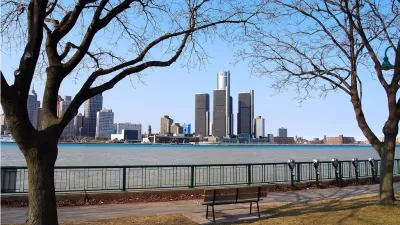After two years of work, hundreds of meetings, and 70,000 survey responses and comments from participants, Detroit will today release the strategic framework plan that will guide the city's long-term recovery, reports Leonard N. Fleming.
The plan, which began in 2010 under the auspices of the Detroit Works project, and is now being called Detroit Future City, is oriented around five key elements - economic growth, land use, city systems, neighborhoods and land and building assets. According to Fleming, it "involves everything from creatively reusing large swaths of empty land and expanded public transportation to supporting local businesses and finding ways to help foster economic growth."
One of the primary challenges for the authors of the plan was how to reconcile a shrinking population of about 700,000 with an infrastructure and environment built to support a population that reached nearly 2 million in 1950.
"Organizers said parts of the plan could take up to 50 years to implement, but other changes intended to stabilize neighborhoods could happen sooner. Residents living in less densely populated areas, for example, would not be required to leave but could expect natural areas and hiking trails built around them in years to come. And in some areas where services are more prevalent, rezoning efforts could lead to business growth in areas that are now considered residential." As Fleming notes, the city would also provide incentives to encourage residents to move into more populated areas.
"Organizers said they wanted to build a "framework for decision-making" with specific goals in the first five years to stabilize the city through more reliable services, improve the city through 2020 with economic growth, sustain Detroit through 2030 with a more stabilized population and an increase in jobs, and by 2050, transform it into a premier city."
FULL STORY: Long-term Detroit neighborhood stabilization plan to be unveiled

Maui's Vacation Rental Debate Turns Ugly
Verbal attacks, misinformation campaigns and fistfights plague a high-stakes debate to convert thousands of vacation rentals into long-term housing.

Planetizen Federal Action Tracker
A weekly monitor of how Trump’s orders and actions are impacting planners and planning in America.

In Urban Planning, AI Prompting Could be the New Design Thinking
Creativity has long been key to great urban design. What if we see AI as our new creative partner?

King County Supportive Housing Program Offers Hope for Unhoused Residents
The county is taking a ‘Housing First’ approach that prioritizes getting people into housing, then offering wraparound supportive services.

Researchers Use AI to Get Clearer Picture of US Housing
Analysts are using artificial intelligence to supercharge their research by allowing them to comb through data faster. Though these AI tools can be error prone, they save time and housing researchers are optimistic about the future.

Making Shared Micromobility More Inclusive
Cities and shared mobility system operators can do more to include people with disabilities in planning and operations, per a new report.
Urban Design for Planners 1: Software Tools
This six-course series explores essential urban design concepts using open source software and equips planners with the tools they need to participate fully in the urban design process.
Planning for Universal Design
Learn the tools for implementing Universal Design in planning regulations.
planning NEXT
Appalachian Highlands Housing Partners
Mpact (founded as Rail~Volution)
City of Camden Redevelopment Agency
City of Astoria
City of Portland
City of Laramie





























